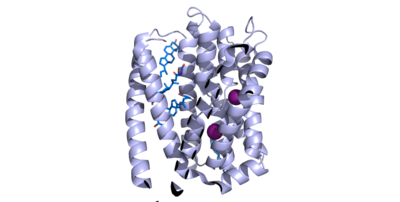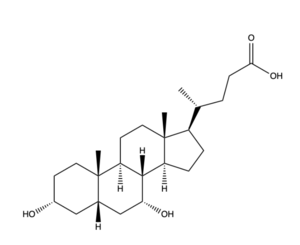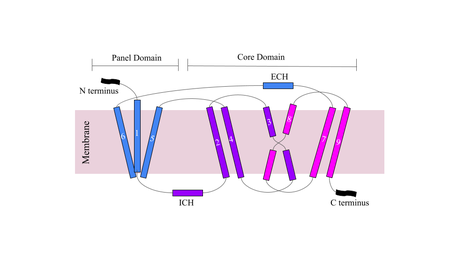Sandbox Reserved 1783
From Proteopedia
(Difference between revisions)
| (75 intermediate revisions not shown.) | |||
| Line 1: | Line 1: | ||
{{Template:CH462_Biochemistry_II_2023}}<!-- PLEASE ADD YOUR CONTENT BELOW HERE --> | {{Template:CH462_Biochemistry_II_2023}}<!-- PLEASE ADD YOUR CONTENT BELOW HERE --> | ||
=== Sodium Taurocholate Co-Transporting Peptide === | === Sodium Taurocholate Co-Transporting Peptide === | ||
| - | <StructureSection load=' | + | <StructureSection load='6lh0' size='340' side='right' caption='NTCP shown with bile salts. The bile salts are colored according to elements, with the overall NTCP structure shown in purple. [https://www.rcsb.org/structure/6LH0]' scene=''> |
== Background == | == Background == | ||
| - | [[Image: | + | [[Image:Fig_1.png|400 px|right|thumb|'''Figure 1.''' NTCP structure with both Na+ ions and bile salts bound with the NTCP molecule shown in light blue, the two Na+ ions shown in purple spheres, and the bile salts shown in sticks as dark blue. [https://www.rcsb.org/structure/7ZYI PDB 7ZYI].]] |
| - | + | ||
| - | NTCP | + | Sodium taurocholate co-transporting polypeptide (NTCP) is a sodium-dependent transporter that is responsible for the transportation of bile salts from the blood into epithelial liver cells. <Ref name="Goutam"> Goutam, K., Ielasi, F.S., Pardon, E. et al. Structural basis of sodium-dependent bile salt uptake into the liver. Nature 606, 1015–1020 (2022). [https://doi.org/10.1038/s41586-022-04723-z DOI: 10.1038/s41586-022-04723-z]. </Ref> NTCP is a secondary active transport molecule that couples the thermodynamically favorable movement of Na+ ions with the unfavorable transport of bile salts into the cell (Fig. 1). |
| - | == | + | The bile salts transported by NTCP in the gastrointestinal tract are involved in digestion, nutrient absorption, fat breakdown, and lipid soluble nutrient transport. <Ref> Maldonado-Valderrama, J., Wilde, P., Macierzanka, A., & Mackie, A. (2011). The role of bile salts in digestion. Advances in colloid and interface science, 165(1), 36–46. [https://doi.org/10.1016/j.cis.2010.12.002 DOI: 10.1016/j.cis.2010.12.002]. </Ref> NTCP is found within the basolateral membrane hepatocytes. <Ref name="Asami"> Asami J, Kimura KT, Fujita-Fujiharu Y, Ishida H, Zhang Z, Nomura Y, Liu K, Uemura T, Sato Y, Ono M, Yamamoto M, Noda T, Shigematsu H, Drew D, Iwata S, Shimizu T, Nomura N, Ohto U. Structure of the bile acid transporter and HBV receptor NTCP. Nature. 2022 Jun; 606 (7916):1021-1026. [https://dx.doi.org/10.1038/s41586-022-04845-4 DOI: 10.1038/s41586-022-04845-4]. </Ref> The uptake of bile salts into the liver also allow for drugs and fat soluble vitamins to be both absorbed and excreted in the small intestine. NTCP also acts as a receptor for Hepatitis B virus (HBV) and Hepatitis D virus (HDV) which infect human livers through endocytosis when bound. The myristoylated (myr) <scene name='95/952711/Pres1_binding_area_on_ntcp/9'>preS1</scene> domain of HBV, specifically residues 8-17, is critical for its binding to NTCP which halts the uptake of bile salts, indicating that HBV/HDV bind to NTCP at the same site as bile salts. <ref name="Goutam"/> |
| - | + | [[Image:Bile Salt structure.png|300 px|left|thumb|'''Figure 2.''' Bile Salt Structure. Chemical structure of bile salt molecule. Bile salt is derivative of cholesterol, as it is a steroid. Bile salts are also the main components of bile.]] | |
| - | + | == Structural Overview == | |
| - | === | + | NTCP has 9 transmembrane alpha helices (TM) that form the protein, with an extracellular N-terminus and intracellular C-terminus. NTCP has two domains within the protein, <scene name='95/952711/Panel_domain/3'>a panel domain</scene>, made up of TM1, TM5, and TM6, and <scene name='95/952711/Core_domain/5'>a core domain</scene>, made up of TM2-4 and TM7-9. An interesting feature of NTCP is the cross of TM3 and TM8 that form an <scene name='95/952711/X_motif/3'>X motif</scene> within the protein that is used in the conformational change of NTCP. The two domains are essential to the conformation change of NTCP to bind bile salts. The intracellular α-helix (ICH) connects TM1 and TM2. The extracellular α-helix connects TM6 and TM7. <Ref name="Xiangbing"> Xiangbing Qi, Wenhui Li. (2022). Unlocking the secrets to human NTCP structure. The Innovation, Vol. 3, Issue 5. 100294, ISSN 2666-6758, [https://doi.org/10.1016/j.xinn.2022.100294 DOI: 10.1016/j.xinn.2022.100294]. </Ref> |
| - | + | There are two significant patches in the NTCP structure that facilitate ligand binding. Residues 84-87 of NTCP are <scene name='95/952711/Binding_patch_1/3'>Patch 1</scene>, which is located on the TM2-TM3 loop in the core domain. This patch is also considered the extracellular region of the binding tunnel within NTCP. Residues 157-165 of NTCP are associated with <scene name='95/952711/Binding_site_2_with_surface/3'>Patch 2</scene>. They are located on the N-terminal half of the TM5 in the panel domain (residue sequence: KGIVISLVL). Patch 2 is also located in the extracellular region of the binding tunnel. These residues' importance was determined through mutations of these residues and examined through pull-down assays. <ref name="Asami"/> The pre-S1 domain of HBV/HDV binds to the patches on NTCP in order to transport the virus from the exterior of NTCP to the interior binding tunnel to infect human liver cells.<ref name="Goutam"/> | |
| - | [[Image: | + | [[Image:Figuredomain.png|450 px|right|thumb|'''Figure 3.''' Cartoon of NTCP topology. This image depicts a basic overview of NTCP structure. The panel domain is shown in blue, while the core domain is shown in pink and purple. The ICH and ECH connect their respective domains to the other. The N-terminus, as shown, is extracellular, whereas the C-terminus is intracellular.]] |
| - | + | === Binding Pocket === | |
| + | <scene name='95/952711/Sodium_residue_zoom_in_nctp/5'>Each sodium binds to a specific set of residues</scene>. Sodium 1 interacts mainly with residues 105, 106, 123, and 257. Sodium 2 interacts mainly with residues 68 and 261. <Ref name="Goutam"> Goutam, K., Ielasi, F.S., Pardon, E. et al. The binding pocket forms a tunnel structure within NTCP at the interface of two domains that connects the external cytoplasm of the hepatocyte to the basolateral membrane. The face of the tunnel where the bile salts bind is lined with hydrophilic residues, whereas the opposite face of the transmembrane helices is hydrophobic, making the tunnel amphipathic. <Ref name="Liu"> Liu, H., Irobalieva, R.N., Bang-Sørensen, R. et al. The structure of human NTCP reveals the basis of recognition and sodium-driven transport of bile salts into the liver. Cell Res 32, 773–776 (2022). [https://doi.org/10.1038/s41422-022-00680-4 DOI: 10.1038/s41422-022-00680-4]. </Ref> The hydrophilic tunnel allows hydrophilic bile salts and sodium ions to be transported across the hydrophobic cell membrane. In the <scene name='95/952711/Tunnel_front/1'>outward facing state</scene> with no bile salt bound to the tunnel, it forms a hollow hole in the middle of the structure. When bile salts bind within, these bile salts completely occlude the <scene name='95/952711/Bile_bound_to_tunnel/1'>tunnel</scene>. | ||
| - | <scene name='95/952711/Binding_site_2/1'>Binding Pocket 2</scene> | ||
=== Conformation Change === | === Conformation Change === | ||
| - | + | The conformational change of NTCP's core domain helices is essential to bile salt binding and uptake. Helices 3 and 8 <scene name='95/952711/X_motif/3'>X motif</scene> are the main structural components of the conformational change, as the X motif has highly conserved polar residue motifs that reside near the bile salt transport sites. The conformational change is energized by the movement of Na+ down its concentration gradient. Before bile salt can bind, the pore in which salt binds must be <scene name='95/952711/Open_pore_ntcp_non_transparent/3'>open</scene>. Conserved glycine and proline residues act as hinges in the connecting short loops, intracellular α-helix, and extracellular α-helix of NTCP to facilitate the movement of the core and panel domain to allow for a conformational change. The <scene name='95/952711/Open_pore_ntcp/3'>open</scene> pore is flipped toward the outer membrane to allow for bile salt binding by exposing the Na+ binding sites and the X motif within NTCP. Once <scene name='95/952711/Open_pore_with_bile_salts/4'>bound</scene>, the pore is <scene name='95/952711/Closed_pore_ntcp/3'>closed</scene>, and bile salt is able to be released into the cell, past the inner membrane. <ref name="Goutam"/> | |
| - | + | ||
| - | The conformational change of NTCP's core domain helices | + | |
=== Mechanism === | === Mechanism === | ||
| - | [[Image:Screenshot_2023- | + | [[Image:Screenshot_2023-04-10_at_4.18.47_PM.png|400 px|right|thumb|'''Figure 4.''' Bile Salt Uptake Mechanism: Conformational Change. This change in structure aids in the uptake of bile salts. The core domain is shown in pink, and the panel domain is light blue. The dark blue structure is bile salt. When the pore is "open," both the core and panel domains are open to the extracellular side. When the pore is "closed," the domains are open to the intracellular space.]] |
| - | The NTCP protein goes through a conformational change when assisting in the uptake of bile salt into the cell. This is accomplished through the opening of a wide transmembrane pore, creating a transport pathway for bile salts. The mechanism includes two <scene name='95/952711/1_sodium_binding_to_ntcp/ | + | The NTCP protein goes through a conformational change when assisting in the uptake of bile salt into the cell. This is accomplished through the opening of a wide transmembrane pore, creating a transport pathway for bile salts. The mechanism includes two <scene name='95/952711/1_sodium_binding_to_ntcp/3'>sodim</scene> metal ions that allow for residue stabilization when going through the conformational change. The binding of the preS1 region of the HBV/HDV virus blocks any subsequent bile salt uptake. Thus, preS1 binding blocks the conformational change and entry of any salts into the cell. Residues 8-17 of preS1 are critical for NTCP:pres1 binding. Patch 1 and Patch 2 (external) residues interact with residues 8-17 of preS1 to facilitate binding. |
== Significance == | == Significance == | ||
| - | + | NTCP is a key player in the absorption and digestion of fats and fat-soluble vitamins in the body, as well as the synthesis of bile within the liver. The uptake of bile salts, transcriptional and post-transcriptional, are signaling molecules for the liver and intestine. Bile salt, the transporting molecule of NTCP, aids in the absorption of lipophilic nutrients and vitamins in the small intestine. Additionally, bile salt plays a role in the endocrine system, excretion of toxins, and cholesterol maintenance. <ref name="Goutam"/> Thus, the significance of NTCP lies with the importance of bile salts; NTCP is necessary in maintaining bile salt levels and thus necessary in maintaining the aforementioned biological processes. | |
=== Bile Salt Uptake === | === Bile Salt Uptake === | ||
| - | [ | + | [https://www.niddk.nih.gov/health-information/liver-disease/cirrhosis/definition-facts Cirrhosis], commonly known as the last stage of liver disease, is due to a deficiency in the bile acid supply in the liver. Bile acid pools, as defined by Vlahcevic, are the negatively-charged precursors to bile and often are conjugated to positively-charged bile salts. This is attributed either a decrease in the production of bile salts or a large increase in the excretion of this molecule out of the cell. <Ref name="Cirrhosis"> Vlahcevic, Z., Buhac, I., et al. Bile Acid Metabolism in Patients with Cirrhosis. Gastroenterology vol. 60, 491-498 (1971). [https://www.gastrojournal.org/article/S0016-5085(71)80053-7/fulltext DOI: 10.1016/S0016-5085(71)80053-7]. </Ref> Cirrhosis causes symptoms such as jaundice, abdominal pain and swelling, and swelling of the legs and feet. A patient who has type two diabetes, those who are biological men, and those who have done or do abuse alcohol are also more susceptible to developing Cirrhosis. This diagnosis can lead to liver failure and other life-threatening diseases, making bile salt uptake essential to liver function. |
| - | Disease of the liver is due to a decrease in bile salt uptake. This disease is transferred through bodily fluids between organisms. Liver Disease causes symptoms such as jaundice, abdominal pain and swelling, and swelling of the legs and feet. Liver disease can lead to liver cancer and other life-threatening diseases, making bile salt uptake essential to liver function. | ||
| - | === HBV/HDV === | ||
| - | |||
| - | Hepatitis B and D both rely on NTCP to bind and infect a human. HBV/HDV uses a similar mechanism as bile salt uptake within NTCP. The myristoylated (myr) pre-S1 domain of HBV is critical for its binding within the protein. Residues 8-17 within the <scene name='95/952711/Pres1_binding_area_on_ntcp/2'>pre-S1 binding</scene> domain were found to be most important in pre-S1 binding to NTCP. HBV/HDV uses the binding patches on the outside of the protein to successfully bind. HBV/HDV binding halts the uptake of bile salt, indicating that the tunnel formed within NTCP allows the uptake of bile salts and may also mediate the binding of HBV/HDV. [[https://www.nature.com/articles/s41586-022-04845-4]] | ||
</StructureSection> | </StructureSection> | ||
== References == | == References == | ||
<references/> | <references/> | ||
| + | |||
| + | == Student Contributors == | ||
| + | |||
| + | Olivia Simcox, Tatiana Pereda, and Kenna King; Butler University, April 2023 | ||
Current revision
| This Sandbox is Reserved from February 27 through August 31, 2023 for use in the course CH462 Biochemistry II taught by R. Jeremy Johnson at the Butler University, Indianapolis, USA. This reservation includes Sandbox Reserved 1765 through Sandbox Reserved 1795. |
To get started:
More help: Help:Editing |
Sodium Taurocholate Co-Transporting Peptide
| |||||||||||
References
- ↑ 1.0 1.1 1.2 1.3 1.4 1.5 Goutam, K., Ielasi, F.S., Pardon, E. et al. Structural basis of sodium-dependent bile salt uptake into the liver. Nature 606, 1015–1020 (2022). DOI: 10.1038/s41586-022-04723-z.
- ↑ Maldonado-Valderrama, J., Wilde, P., Macierzanka, A., & Mackie, A. (2011). The role of bile salts in digestion. Advances in colloid and interface science, 165(1), 36–46. DOI: 10.1016/j.cis.2010.12.002.
- ↑ 3.0 3.1 Asami J, Kimura KT, Fujita-Fujiharu Y, Ishida H, Zhang Z, Nomura Y, Liu K, Uemura T, Sato Y, Ono M, Yamamoto M, Noda T, Shigematsu H, Drew D, Iwata S, Shimizu T, Nomura N, Ohto U. Structure of the bile acid transporter and HBV receptor NTCP. Nature. 2022 Jun; 606 (7916):1021-1026. DOI: 10.1038/s41586-022-04845-4.
- ↑ Xiangbing Qi, Wenhui Li. (2022). Unlocking the secrets to human NTCP structure. The Innovation, Vol. 3, Issue 5. 100294, ISSN 2666-6758, DOI: 10.1016/j.xinn.2022.100294.
- ↑ Vlahcevic, Z., Buhac, I., et al. Bile Acid Metabolism in Patients with Cirrhosis. Gastroenterology vol. 60, 491-498 (1971). DOI: 10.1016/S0016-5085(71)80053-7.
Student Contributors
Olivia Simcox, Tatiana Pereda, and Kenna King; Butler University, April 2023




